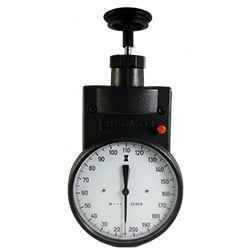The Significance of a Tachometer in Checking Engine Speed and Efficiency in Automotive Applications
In the realm of vehicle engineering, the tachometer stands as a crucial instrument in the vehicle driver's toolbox, giving a direct home window into the internal operations of an automobile's engine. Past its function as a simple scale of revolutions per minute (RPM), the tachometer works as an important device for enthusiasts and experts alike, supplying real-time insights right into engine efficiency and health and wellness. Understanding the relevance of this tool surpasses surface-level observations, diving right into the elaborate partnership between engine speed, power outcome, and total driving experience. As we discover the multifaceted role of the tachometer in vehicle applications, a much deeper appreciation for its effect on vehicle characteristics and performance begins to emerge.
Significance of Keeping Track Of Engine RPM
Checking engine RPM, or revolutions per minute, is a vital element of vehicle upkeep and efficiency evaluation. Engine RPM straight associates with the rate at which the engine's crankshaft rotates, suggesting exactly how quickly the engine is running - tachometer. By keeping track of RPM, technicians can examine the health of the engine, identify potential issues, and fine-tune efficiency. An unusual RPM analysis may signify problems such as engine misfires, malfunctioning trigger plugs, or issues with the fuel delivery system. Continually high RPM readings might show hostile driving behaviors or the demand for a higher gear change to improve fuel effectiveness.
Furthermore, keeping track of engine RPM is essential for efficiency analysis in auto racing and high-performance automobiles. In summary, checking engine RPM is not just important for detecting problems however also for optimizing engine efficiency in numerous automobile applications.

Advantages of Real-Time Information
In vehicle applications, real-time data plays a crucial duty in giving instantaneous understandings right into the performance and condition of the vehicle. By continuously monitoring different parameters such as engine rate, temperature, fuel consumption, and extra, real-time data uses many advantages that add to boosted performance and safety when traveling.
One substantial advantage of real-time information is its capacity to sharp chauffeurs and service technicians to any type of abnormalities or issues quickly. This positive technique makes it possible for fast recognition of prospective troubles, permitting for prompt interventions to avoid additional damage or breakdowns. Furthermore, real-time information assists in efficiency optimization by giving prompt responses on driving behaviors and engine efficiency. Vehicle drivers can readjust their behavior in real-time based on this info to accomplish far better gas economy and lengthen the lifespan of their automobile.

Additionally, real-time information plays an important function in modern vehicle diagnostics, allowing professionals to quickly diagnose and attend to breakdowns. This brings about reduced downtime, reduced maintenance costs, and ultimately, boosted total car reliability and long life (tachometer). By harnessing the power of real-time information, automobile stakeholders can make informed decisions that favorably influence both the find this performance and long life of the automobile
Influence On Equipment Shifts
The tachometer plays a critical duty in maximizing equipment changes by supplying real-time engine speed information to the vehicle driver. When coming close to the redline on the tachometer, it signifies the vehicle driver to upshift to protect against over-revving the engine and creating possible damage.
Furthermore, the tachometer aids in achieving smoother gear changes, specifically in hand-operated transmissions. By checking engine rate, vehicle drivers can implement equipment shifts at the optimal RPM array, lowering jerking motions and minimizing wear on the transmission components. This accuracy on duty modifications not only boosts driving convenience but also adds to fuel performance.
Enhancing Gas Efficiency
Offered the important function the tachometer plays in optimizing gear shifts for efficiency and engine health resource and wellness, it directly adds to making best use of gas efficiency in auto applications. By offering real-time comments on you could check here engine rate, the tachometer assists chauffeurs in keeping the most reliable RPM variety for fuel economic situation. When chauffeurs consistently keep an eye on the tachometer and adjust their driving habits as necessary, they can avoid unneeded fuel usage brought on by over-revving or carrying the engine.
Furthermore, the tachometer helps motorists identify the most fuel-efficient equipment to be in at any provided minute, avoiding the engine from functioning more challenging than necessary. This is especially crucial throughout acceleration and cruising, where remaining in the right gear can substantially affect fuel efficiency. Furthermore, the tachometer can notify chauffeurs to possible mechanical problems that could be adversely influencing gas economic climate, such as a sliding clutch or a blocked air filter. In verdict, the tachometer functions as an important device in boosting gas effectiveness by advertising optimum driving behaviors and identifying areas for enhancement in the automobile's efficiency.

Maximizing Engine Longevity
The tachometer's role in monitoring engine rate and efficiency contributes in making sure the durability of auto engines. By making use of the tachometer successfully, motorists can enhance engine longevity via conscious RPM administration. Consistently revving an engine too expensive can result in excessive damage on important elements, such as the pistons, valves, and bearings. With time, this can lead to decreased engine efficiency and prospective malfunctions. Monitoring the tachometer permits chauffeurs to stay within the suggested RPM range for their lorry, stopping unnecessary strain on the engine and prolonging its lifespan.

Final Thought
In conclusion, the tachometer plays a crucial function in monitoring engine rate and performance in vehicle applications. By giving real-time data on RPM, it permits for effective equipment shifts, boosted fuel performance, and taken full advantage of engine long life. This tool is essential for preserving optimal engine performance and making certain the overall capability of a vehicle.
Comments on “Comprehensive Overview to Understanding and Using a Tachometer Successfully”